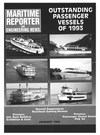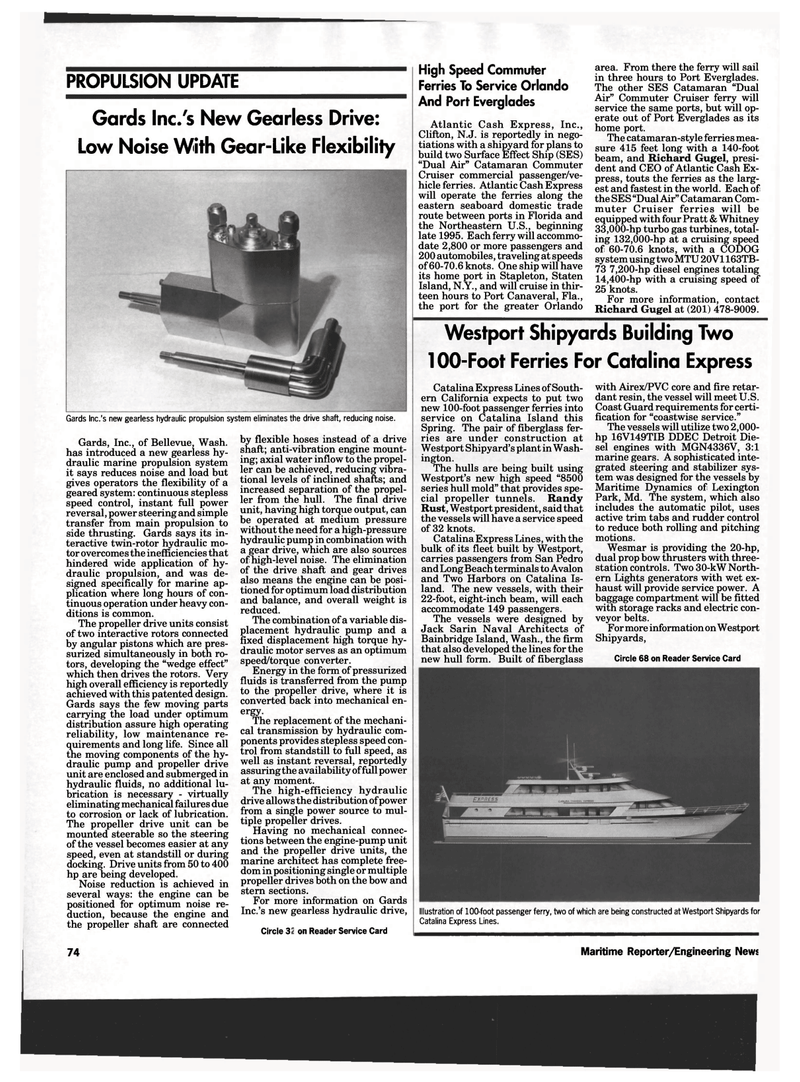
Page 72: of Maritime Reporter Magazine (January 1994)
Read this page in Pdf, Flash or Html5 edition of January 1994 Maritime Reporter Magazine
PROPULSION UPDATE
Gards Inc/s New Gearless Drive:
Low Noise With Gear-Like Flexibility
Gards Inc.'s new gearless hydraulic propulsion system eliminates the drive shaft, reducing noise.
Gards, Inc., of Bellevue, Wash, has introduced a new gearless hy- draulic marine propulsion system it says reduces noise and load but gives operators the flexibility of a geared system: continuous stepless speed control, instant full power reversal, power steering and simple transfer from main propulsion to side thrusting. Gards says its in- teractive twin-rotor hydraulic mo- tor overcomes the inefficiencies that hindered wide application of hy- draulic propulsion, and was de- signed specifically for marine ap- plication where long hours of con- tinuous operation under heavy con- ditions is common.
The propeller drive units consist of two interactive rotors connected by angular pistons which are pres- surized simultaneously in both ro- tors, developing the "wedge effect" which then drives the rotors. Very high overall efficiency is reportedly achieved with this patented design.
Gards says the few moving parts carrying the load under optimum distribution assure high operating reliability, low maintenance re- quirements and long life. Since all the moving components of the hy- draulic pump and propeller drive unit are enclosed and submerged in hydraulic fluids, no additional lu- brication is necessary - virtually eliminating mechanical failures due to corrosion or lack of lubrication.
The propeller drive unit can be mounted steerable so the steering of the vessel becomes easier at any speed, even at standstill or during docking. Drive units from 50 to 400 hp are being developed.
Noise reduction is achieved in several ways: the engine can be positioned for optimum noise re- duction, because the engine and the propeller shaft are connected by flexible hoses instead of a drive shaft; anti-vibration engine mount- ing; axial water inflow to the propel- ler can be achieved, reducing vibra- tional levels of inclined shafts; and increased separation of the propel- ler from the hull. The final drive unit, having high torque output, can be operated at medium pressure without the need for a high-pressure hydraulic pump in combination with a gear drive, which are also sources of high-level noise. The elimination of the drive shaft and gear drives also means the engine can be posi- tioned for optimum load distribution and balance, and overall weight is reduced.
The combination of a variable dis- placement hydraulic pump and a fixed displacement high torque hy- draulic motor serves as an optimum speed/torque converter.
Energy in the form of pressurized fluids is transferred from the pump to the propeller drive, where it is converted back into mechanical en- ergy.
The replacement of the mechani- cal transmission by hydraulic com- ponents provides stepless speed con- trol from standstill to full speed, as well as instant reversal, reportedly assuring the availability of full power at any moment.
The high-efficiency hydraulic drive allows the distribution of power from a single power source to mul- tiple propeller drives.
Having no mechanical connec- tions between the engine-pump unit and the propeller drive units, the marine architect has complete free- dom in positioning single or multiple propeller drives both on the bow and stern sections.
For more information on Gards
Inc.'s new gearless hydraulic drive,
Circle 236 on Reader Service Card
High Speed Commuter
Ferries To Service Orlando
And Port Everglades
Atlantic Cash Express, Inc.,
Clifton, N.J. is reportedly in nego- tiations with a shipyard for plans to build two Surface Effect Ship (SES) "Dual Air" Catamaran Commuter
Cruiser commercial passenger/ve- hicle ferries. Atlantic Cash Express will operate the ferries along the eastern seaboard domestic trade route between ports in Florida and the Northeastern U.S., beginning late 1995. Each ferry will accommo- date 2,800 or more passengers and 200 automobiles, traveling at speeds of60-70.6 knots. One ship will have its home port in Stapleton, Staten
Island, N.Y., and will cruise in thir- teen hours to Port Canaveral, Fla., the port for the greater Orlando area. From there the ferry will sail in three hours to Port Everglades.
The other SES Catamaran "Dual
Air" Commuter Cruiser ferry will service the same ports, but will op- erate out of Port Everglades as its home port.
The catamaran-style ferries mea- sure 415 feet long with a 140-foot beam, and Richard Gugel, presi- dent and CEO of Atlantic Cash Ex- press, touts the ferries as the larg- est and fastest in the world. Each of the SES "Dual Air" Catamaran Com- muter Cruiser ferries will be equipped with four Pratt & Whitney 33,000-hp turbo gas turbines, total- ing 132,000-hp at a cruising speed of 60-70.6 knots, with a CODOG system using two MTU 20V1163TB- 73 7,200-hp diesel engines totaling 14,400-hp with a cruising speed of 25 knots.
For more information, contact
Richard Gugel at (201) 478-9009.
Westport Shipyards Building Two 100-Foot Ferries For Catalina Express
Catalina Express Lines of South- ern California expects to put two new 100-foot passenger ferries into service on Catalina Island this
Spring. The pair of fiberglass fer- ries are under construction at
Westport Shipyard's plant in Wash- ington.
The hulls are being built using
Westport's new high speed "8500 series hull mold" that provides spe- cial propeller tunnels. Randy
Rust, Westport president, said that the vessels will have a service speed of 32 knots.
Catalina Express Lines, with the bulk of its fleet built by Westport, carries passengers from San Pedro and Long Beach terminals to Avalon and Two Harbors on Catalina Is- land. The new vessels, with their 22-foot, eight-inch beam, will each accommodate 149 passengers.
The vessels were designed by
Jack Sarin Naval Architects of
Bainbridge Island, Wash., the firm that also developed the lines for the new hull form. Built of fiberglass with Airex/PVC core and fire retar- dant resin, the vessel will meet U.S.
Coast Guard requirements for certi- fication for "coastwise service."
The vessels will utilize two 2,000- hp 16V149TIB DDEC Detroit Die- sel engines with MGN4336V, 3:1 marine gears. A sophisticated inte- grated steering and stabilizer sys- tem was designed for the vessels by
Maritime Dynamics of Lexington
Park, Md. The system, which also includes the automatic pilot, uses active trim tabs and rudder control to reduce both rolling and pitching motions.
Wesmar is providing the 20-hp, dual prop bow thrusters with three- station controls. Two 30-kW North- ern Lights generators with wet ex- haust will provide service power. A baggage compartment will be fitted with storage racks and electric con- veyor belts.
For more information on Westport
Shipyards,
Circle 68 on Reader Service Card
Illustration of 100-foot passenger ferry, two of which are being constructed at Westport Shipyards for
Catalina Express Lines. 74 Maritime Reporter/ Engineering News

 71
71

 73
73
